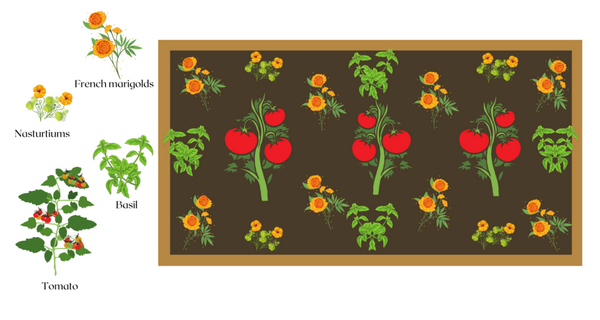Ad Blocker Detected
Our website is made possible by displaying online advertisements to our visitors. Please consider supporting us by disabling your ad blocker.
Marigolds are not only beautiful and resilient flowers but also offer various benefits and uses in gardens and landscapes. Let’s explore the different ways marigolds can be utilized.
Companion Plants

Marigolds are highly regarded as excellent companion plants, especially in vegetable gardens. They contain chemical compounds that naturally deter harmful insects and pests, protecting neighboring vegetable plants. Additionally, marigolds are known to prevent nematodes, which are soil-borne pests that can cause damage to plant roots.
Cut Flower Gardens
While commonly used as companion plants in vegetable gardens, marigolds can also enhance the beauty of cut flower gardens. They pair well with other annuals like zinnias, adding vivid colors and diversity to floral arrangements.
Pest Control
Marigolds possess the ability to repel certain insects and pests, making them an effective natural pest control option. However, it’s important to note that marigolds are not invincible and can still be susceptible to some pests. Here are a few pests that may affect marigolds and how to deal with them:
Aphids
Aphids are small green insects that feed on plant stems and foliage. They can cause damage to marigolds, resulting in browning or yellowing foliage. Applying an insecticidal soap or spray can help eliminate aphids on contact.
Slugs and Snails
Slugs and snails are common garden pests that can harm marigold plants, particularly during periods of frequent rain. Handpicking and placing them in a bucket of soapy water can effectively remove these pests.
Thrips
Thrips are cigar-shaped insects that typically attack young foliage and stems. Neem oil spray is an effective solution for combating thrips on marigold plants.
Diseases
Marigolds may also be susceptible to certain diseases, especially when grown in warm and wet conditions or in proximity to infected plants. Here are a couple of common diseases and their remedies:
Powdery Mildew
Powdery mildew appears as a white or gray powdery substance on the leaves. To combat powdery mildew, you can create a solution using water and Epsom salts and apply it to the affected leaves.
Damping Off
Damping off is a condition often observed in young seedlings, characterized by wilting and spots on the plant tissue. It can be prevented by planting marigolds in well-drained soil and ensuring proper air circulation.
By understanding the various uses of marigolds and taking appropriate measures to address pests and diseases, you can fully enjoy the benefits these versatile flowers offer in your garden.
Final Thoughts
Marigolds have stood the test of time and continue to be beloved by home gardeners for numerous reasons. Their enduring popularity can be attributed to their hassle-free nature and ability to bloom consistently throughout the entire season, even in hot climates.
Whether you choose to start from seeds or opt for transplants, marigolds are readily accessible during the growing season and make a fantastic addition to any sun-drenched patio or garden space. With their vibrant colors and low maintenance requirements, marigolds are sure to bring joy and beauty to your outdoor areas.

